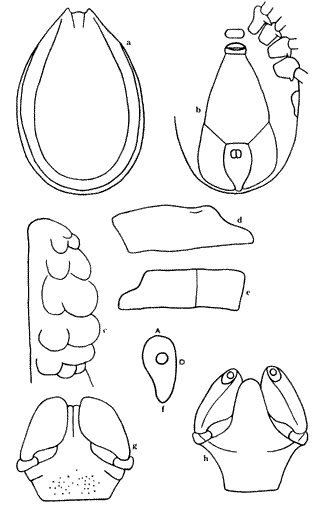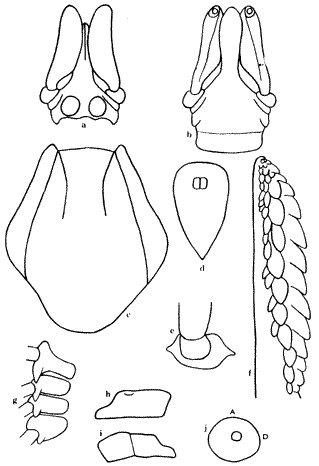IXODES CORNUATUS, sp. nov. (indigenous tick)
from Roberts FHS (1960): A systematic study of the Australian species of the genus Ixodes (Acarina: Ixodidae). Australian Journal of Zoology 8:392-485.
Ixodes holocyclus Roberts, 1954, p.144.
Ixodes cornuata Roberts, 1959, p. 268.
Male. Female. The nymph and larva of this species are unknown.
Holotype-Male, Cox's Bight, Tas., April 1940, (C. D. King), in the National Museum, Melbourne. Host unknown.
Allotype-Female (partly engorged), Victoria, 17.iv.1953 (J. Membrey), in the National Museum, Melbourne. Host: Canis familiaris.
Paratypes.-Male (mounted), Warragul district, Vie., February 1958, host unknown; unfed female (mounted), Noojee, Neerim North, Vic.,9.vii.1908, (T. G. Robinson), "kangaroo"; engorged female, Lakes Entrance, Vic.,
October 1919 (F.E. Wilson), Canis familiaris (paralysis); engorged female, Lakes Entrance, 12.ii.1958 (K. Gotchie), host unknown; unfed female, Lakes Entrance, 30.iii.1956, host unknown; partly fed female, Broulee, N.S.W., ~2.i. 1949, host Felis catus; unfed female, Cox's Bight, June 1939 (D. King), host unknown; semi-engorged female, Gordon R., Tas., January 1949 (Capt. Sutton), host unknown. The paratypes from Warragul, Noojee, Broulee, and from C. familiaris, October 1919, Lakes Entrance, are in the collection of the Veterinary Parasitology Laboratory, C.S.I.R.O., Yeerongpilly, Qld., those from unknown hosts, Lakes Entrance, 12.ii.1958 and 30.iii.1956, and from Gordon R. are in the National Museum, Melbourne; that from Cox's Bight is in the Tasmanian Museum, Hobart.
Male
Fig. 35, a-h
Diaqnosis
A relatively large tick, lateral grooves well defined and completely encircling the scutum, punctations fine, no lateral carinae; capitulum short, the basis punctate dorsally, no cornua, palpi short and very broad, article 1 with a well-developed, erect, keel-like flange ventrally; anal plate bluntly pointed behind; coxae with an external spur, trochanters with an external tuberosity; tarsi terminating a little abruptly.
Description
Body.-Broadly oval, 4.4 by 2.8 mm, widest in region of spiracles; marginal body fold commencing at level of coxa III, narrow; hairs relatively few dorsally, more numerous ventrally.
Capitulum.-Short, 0.7 mm in length; basis dorsally 0.64 mm wide, surface punctate, posterior margin straight, posterolateral margins straight and divergent anteriorly, no cornua; basis ventrally with the posterior margin almost straight, palpi short, flat, very road, article I wider than long, rounded and salient laterally, ventrally with an erect, keel-like flange in line with ridges on the basis, articles 2 and 3 are apparently fused, widest medianly and not quite half as wide as long.
Hypostome short and broad, about 0.34 mm in length; dentition 2/2 of about 5 rows of rounded teeth, the external file larger than the internal file, followed by 2 rows of crenulation.

Fig 35.- I cornuatus, male: a, body (dorsal view); b, body (ventral view); c, hypostome; d, tarsus I; e, tarsus IV; f, spiracular plate; g, capitulum (ventral view).
Scutum.- Convex, oval, the lateral grooves well defined and complete; no lateral carinae; punctations fine, scattered, slightly coarser and more numerous anteriorly and laterally; cervical grooves short, shallow, convergent; emargination moderate; scapulae bluntly pointed.
Genital aperture.-At level of anterior margin of coxa III.
Ventral plates.-Pregenital plate wider than long; median plate widening posteriorly to become a little more than three times its width anteriorly, 2.3 mm by 1.4 mm; anal plate 0.9 by 0.6 mm, the anterior margin straight, bluntly pointed posteriorly at body margin; adanal plates curving posteriorly and inwardly to fuse behind the point of the anal plate; ventral plates, particularly the adanals, with some fine, scattered punctations.
Spiracular plates -Relatively large, elongate oval, narrower posteriorly, the longer axis directed anteriorly, 0.71 by 0.36 mm, the macula anterior to centre.
Legs.-length moderate, relatively stout, with many short bristles: coxae contiguous or almost so, each with a row of long hairs near the posterior margin and with an external spur, the spurs decreasing in size posteriorly; trochanters with external, rounded, spur-like protrusion most developed on trochanters II and III, tarsi tapering somewhat abruptly, tarsus I 0.82 mm in length tarsus IV 0.79 mm in length.
Female
Fig. 36, a-j
Diagnosis
A holocyclus-like tick with a long capitulum; cornua well defined and bluntly pointed, porose areas deep, large, auriculae strong, palpal article I with dorsal and ventral flanges, hypostome lanceolate, dentition mainly 3/3; scutum slightly longer than wide and widest at about mid-length, with strong, lateral carinae; no sternal plate; anal groove closed behind; all coxae with external spurs; tarsi tapering rather abruptly.
Description
Body.-Oval, widest at level of spiracles, 4.7 by 3.3 mm (unfed); marginal grooves well developed and complete; some scattered, pale hairs more numerous ventrally.
Capitulum.-Long, 1.5 mm; basis dorsally 0.85 mm wide, the lateral fields somewhat swollen, posterior margin sinuous, posterolateral margins divergent anteriorly, cornua well developed and bluntly pointed; porose areas large, broadly oval, deep, the interval depressed and less than the width of one; basis ventrally with strong, blunt auriculae and with faint transverse suture, posterior margin rounded; palpi long and slender, article 1 wider than long, rounded and somewhat salient laterally, with a small, erect, dorsal flange and a more strongly developed keel-like flange ventrally, articles 2 and 3 apparently fused 1.1 mm in length, narrow at base, the apex rounded, and reaching at mid-length a width of about one-third the length.
Hypostome lanceolate, 0 96 mm in length ; bluntly pointed; dentition mainly 3/3, but 2/2 basally and some rows of 4/4 of small teeth distally, file 1 with about 12 large pointed teeth, file 2 with about 10-12 smaller teeth, and file 3 with a number of tiny teeth crowded distally.
Scutum.- slightly longer than wide, 2.5 by 2.3 nim, and widest at about mid-length, somewhat flat medianly, convex laterally, lateral carinae strong, slightly curved convergently to reach the posterior margin; anterolateral margins and posterolateral margins sinuous, the posterior angle broadly rounded punctations fine, scattered, somewhat coarser and more numerous in scapular fields cervical grooves well developed anteriorly, at first convergent, then continuing to about midscutum as very shallow, divergent depressions; emargination moderate; scapulae bluntly pointed.

Fig. 36.-I. cornuatus, female: a, capitulum (dorsal view); b, capitulurn (ventral view); c, scutum; d, anal grooves; e, palpal article 1 (lateral view); f, hypostome; g coxae; h, tarsus I; i, tarsus IV; j, spiracular plate.
Genital aperture.-At level of coxa IV.
Genital groove.-Divergent to about level of anus then curved convergently.
Anal groove. Convex anteriorly and curved posteriorly to meet in an elongate point.
Spiracular plate.-Subcircular and about 0.53 mm in diameter.
Legs.-Relatively long and somewhat stout; coxae flat, each with a row of hairs towards the posterior margin and with well-defined external spurs decreasing in size posteriorly, the spur on coxa I long and blunt; trochanters with external tuberosities, most developed on trochanters II-III; tarsi tapering somewhat abruptly, tarsus I 1.07 mm in length, tarsus IV 0.9 mm in length.
Comments
The paratypes differed little from the type specimens and these differences were only slight and confined to measurements. The male's body measurements were 3.5 by 2.5 mm. In the females, the engorged specimens measured up to 14.3 by 11.0 mm and the scuta of these females varied from 2.5 by 2.2 mm to 2.8 by 2.4 mm. The material available for examination included a female from an unknown host, Nubeena, Tas., 12.x.1948, which was too damaged to be included as a paratype.
Roberts (1954) discussing the distribution of I. holocyclus in Victoria noted that the specimens (females) on which his remarks were based were larger than females from Queensland and New South Wales. Unfed females from these two States measured 2.6 to 3.8 mm in length and their scuta 1.9 by 1.9 mm to 2.3 by 2.2 mm, whereas these measurements for the Victorian specimens were 4.3 to 4.6 mm and 2.5 by 2.4 mm to 2.7 by 2.6 mm respectively." These specimens were from an unknown host, Warragul district, a dog, Warburton, a koala, Sassafras, and from an unknown host, Mt. Buffalo. None of these specimens, unfortunately, were available for re-examination, but the author's recollection of the presence of well-developed cornua places them as I. cornuatus.
The presence of an engorged female on a dog suffering from tick paralysis is significant, but further evidence is required before the role of this species in causing this disease can be assessed.
I. cornuatus and I. holocyclus are the only two species of Sternalixodes in which a sternal plate is absent in the female. The two species, particularly the males, are also very similar in other morphological respects. Measurements are compared in Table 1.
In addition to the well-developed cornua, the female I. cornuatus may be distinguished from I. holocyclus by the hypostome dentition (see Figs. 30d and 36f).
The Paralysis Tick of Australia - Home
E-mail Us to report a broken link!